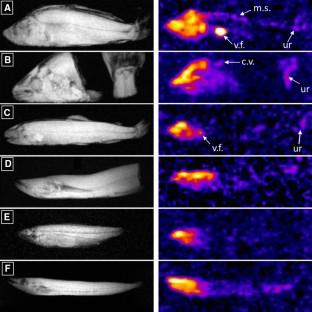Applied Magnetic Resonance ( IF 1.1 ) Pub Date : 2022-05-30 , DOI: 10.1007/s00723-022-01480-0 N. V. Anisimov , V. V. Shakhparonov , A. V. Romanov , A. A. Tarasova , I. A. Usanov , O. S. Pavlova , M. V. Gulyaev , Yu. A. Pirogov

|
Sodium (23Na) magnetic resonance imaging (MRI) provides information about intra- and intercellular processes useful for medical diagnostics, such as Huntington’s disease, diabetes, etc. 23Na MRI is also used for technological applications such as the analysis of salt content in food products and the assessment of their characteristics using relaxation measurements. Due to 3–4 order difference in the MRI sensitivity for proton and sodium detection, 23Na MRI is usually performed using high-field MRI scanners. Current study explores feasibility of 23Na MRI at the low field 0.5T clinical scanner using different fish species. Using the 3D gradient echo method with the parameters: repetition time = 44.7 ms, echo time = 12 ms, and flip angle = 75°, 23Na MRI of euthanized and thawed fish of different orders (according to biological classification) with an isotropic resolution of 6 mm were obtained. For the assignment of anatomical structures of fish, proton images with an isotropic resolution of 2 mm were also obtained, and combined 1H and 23Na images were constructed. The analysis of the obtained images, including anatomical aspects, has been carried out. Using 23Na nuclear magnetic resonance spectroscopy methods, the rate of sodium excretion was assessed for typical methods of fish conservation for their subsequent use as anatomical specimens and exhibits in museums and scientific laboratories. The results of this work can be used to assess the potential of low-field multinuclear MRI, in biology, and technological (non-medical) applications, particularly, in the analysis of food and the development of methods for preservation of living tissues.
中文翻译:

0.5T 临床扫描仪上鱼的钠 MRI
钠 ( 23 Na) 磁共振成像 (MRI) 提供有关对医学诊断有用的细胞内和细胞间过程的信息,例如亨廷顿病、糖尿病等23 Na MRI 还用于技术应用,例如分析盐含量食品和使用松弛测量对其特性的评估。由于质子和钠检测的 MRI 灵敏度存在 3-4 个数量级差异,因此23 Na MRI 通常使用高场 MRI 扫描仪进行。目前的研究探讨了23使用不同鱼类的低场 0.5T 临床扫描仪的 Na MRI。使用 3D 梯度回波法,参数为:重复时间 = 44.7 ms,回波时间 = 12 ms,翻转角 = 75°,23 Na MRI 对不同阶(根据生物分类)的安乐死和解冻的鱼进行各向同性分辨率获得了 6 毫米。对于鱼的解剖结构分配,还获得了各向同性分辨率为 2 mm 的质子图像,并构建了1 H 和23 Na 组合图像。已经对获得的图像进行了分析,包括解剖学方面。使用23Na 核磁共振波谱法,钠排泄率被评估为鱼类保护的典型方法,以便它们随后用作解剖标本和博物馆和科学实验室的展品。这项工作的结果可用于评估低场多核 MRI 在生物学和技术(非医学)应用中的潜力,特别是在食品分析和活体组织保存方法的开发方面。











































 京公网安备 11010802027423号
京公网安备 11010802027423号